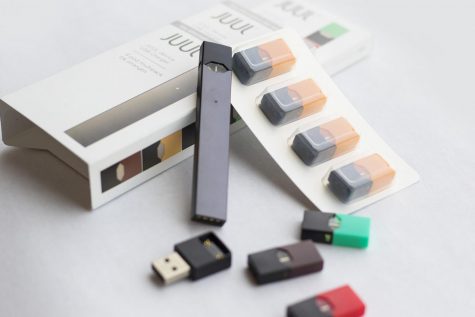Y’all Went and Got a Nicotine Addiction for Fun
Since the product launch in July of 2017, Juuling in schools is an epidemic which continues to grow. The product, made initially as an e-cigarette to help people curb smoking addictions, has found its way into high schools and created a more significant problem rather than its intended solution. The evolution of the Juul–in its respects to high school students–is a growing problem and should be dealt with appropriately.
Many people have seen images on the internet of “why are people peeing in the Juul room.” Although funny, this highlights a big problem within schools. A survey conducted by The Catalyst showed that in a survey of 181 students, only 10% said they didn’t have a friend who owned a Juul or own one themselves. Of these same students, 58% said that they had “hit” a Juul during school. Not only does this distract students from their studies, but it also creates a dependency on an addictive chemical. According to the CDC, “Nicotine is one of the most addictive chemicals we know of,” which is why Juuling in teens is such a big problem. Even though there is not enough research to link nicotine to cancer, the CDC says Juuling is still harmful, as “Nicotine exposure during adolescence can cause addiction and can harm the developing brain,” which is cause for concern, as the rate at which teens are exposed to nicotine increases. Additionally, the National Institute for Drug Abuse found that 30.7% of e-cigarette users are more likely to start smoking cigarettes within six months.
In an attempt to help students, the administration at Wheeler High School has guidelines set up on how to handle situations involving e-cigarettes. The actions were taken against those caught using vapes in school range from two days out of school suspension, for a first offence, to long-term suspension (i.e., the rest of the school year), after multiple crimes have occurred. The appearance of Juuls mimics that of a flash drive, and many teachers are unaware of what it is when they see one. For this reason, teachers may not even be aware of what is going on in their classrooms and the hallways. In an interview, Principal, Peter Giles, stated that while teachers do not receive formal training on this topic, they have become more educated on what to look for through simple conversation, as well as students identifying others. For this reason, the number of vaping-related referrals has increased since the beginning of the year. Even though vaping in school is a problem, teachers and administration are doing their best to keep the issue under control for the good of the students, even if they do not realize it yet.



Mikayla Hadlow is a 12th grader at Wheeler, and one of her favorite high school memories is when she and some of her best friends went to the beach together...





